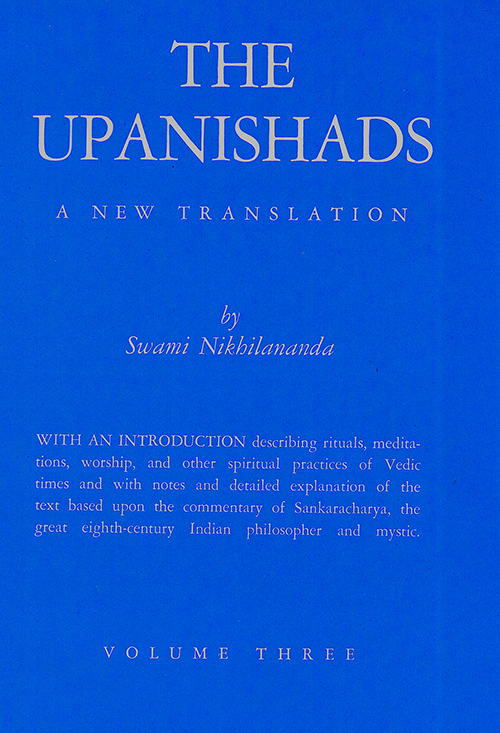
The Upanishads (Volume 3)
Swami Nikhilananda. Aitareya and Brihadaranyaka Upanishads. With Introduction
Cloth: $19.95
Excerpt from the Introduction to the Brihadaranyaka Upanishad.
The Brihadaranyaka Upanishad presents a comprehensive view of life, which includes both the enjoyment of happiness in the phenomenal world and the attainment of the Highest Good, or Liberation. The former is achieved through religious rites - called karma, or work - and the latter through Vidya, or the Knowledge of the identity of the individual self and Brahman, or the Supreme Self. The word karma in The Upanishads denotes primarily the sacrificial rites by which the worshipper communes with the deities through the offering of oblations. Sometimes it also signifies work for the public welfare (purta). Different deities (devatas or devas) are invoked in different religious rites. Rites, in order to be fruitful, must be accompanied by appropriate meditations (upasana) on the deities.
The deities who fulfill worldly boons are different manifestations of Brahman. It is really Brahman who fulfills desires through these manifestations. The highest manifestation is Prajapati, also called Hiranyagarbha, Viraj, and Prana. Prajapati supports the creation as the cosmic energy. He also dwells in the embodied creature as the prana, or vital breath, and supports the body and organs. As energy He pervades the entire creation; but his personal aspect is admitted by the scriptures for facility of meditations by the worshipper. He is also meditated upon through such symbols as Om, the Gayatri, the sun, the moon, the mind, and the prana in the individual. Through meditation one becomes like the object meditated upon; therefore by meditating on Prajapati the worshipper realizes, in the end, his own identify with all the created beings. This enables him to enjoy the highest happiness in the creation; he overcomes the idea of separateness, which is the cause of selfishness, sin, and suffering. By propitiating the minor deities, one enjoys finite happiness on earth or in the heavenly worlds.
It should be noted that the whole idea of rites and meditations is based upon the acceptance of the multiplicity of worshipper, result, accessories, and deities. According to non-dualistic Vedanta, multiplicity is the result of avidya, or nescience. Reality is one and without a second; the Knowledge of Reality can be attained only through the realization of the oneness of existence. This Knowledge is the final teaching of The Upanishads.
According to Sankaracharya, karma (including meditation on the deities) and the Knowledge of Brahman, having altogether different aims, are fundamentally opposed to each other, like darkness and light. They cannot co-exist. There is no relationship or meeting-ground between them, just as no meeting-ground exists between darkness and light, or the mirage and the desert.
Yet there is an important place for karma in the realization of the Knowledge of Brahman. Karma, which is dealt with in the Mantra and Brahmana portions of the Vedas, prepares the aspirant for Knowledge, which is exclusively taught in The Upanishads.
A seeker after Knowledge must first understand that all worldly enjoyments - ranging from that experienced by a clump of grass to that enjoyed by Brahma - are transitory because they all belong to the realm of avidya. Next he must be ready to renounce all desire for worldly enjoyment. His soul, time and again, has taken a body in the world of transmigratory existence and enjoyed the pleasures obtainable there. And his experiences of the enjoyments in the higher worlds has been made possible through the grace of the deities. After being satiated with all the experiences of the relative world, he seeks the Knowledge of Brahman, practices such virtues as discrimination between the real and the unreal, non-attachment to the unreal, restraint of the organs, control of the mind, forbearance with regard to all physical afflictions, and reverence for the scriptures and the teacher. He also cherishes a single-minded longing for liberation from the phenomenal world. And the teacher instructs him about the Knowledge of Brahman, which removes the illusory notion of the world created by ignorance. The destruction of ignorance is concomitant with Knowledge. No other discipline is necessary. This Knowledge liberates one from the otherwise endless chain of rebirth in samsara.
Thus religious rites are not repudiated by The Upanishads, but recognized as a means of creating the right mood for the practice of the higher disciplines. These rites also help the seeker to purify his mind through the enlargement of his consciousness, and to practice concentration.
The importance of the practice of physical, mental, ethical, and spiritual disciplines for the realization of the Knowledge of Brahman cannot be overemphasized. An intelligent person may derive emotional or intellectual excitement from the reading of such statements as "I am Brahman" and "All is verily Brahman." People are not wanting in modern times who glibly say, "Samsara is Nirvana," yet at the same time are attached to worldly pleasures. But the true import of such statements can be understood only by one whose heart has been purified in the fire of spiritual disciplines. The path has been described in the Katha Upanishad as being sharp as the edge of a razor. The Brihadaranyaka Upanishad warns the seeker to guard against such pitfalls as passion, greed, and violence, which are inherent in the life of the world. The Chhandogya Upanishad narrates the story of the demon king who, after being instructed by Prajapati, concludes that the body is Brahman, and asks his followers to provide it with food and raiment and preserve it after death.



